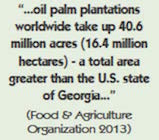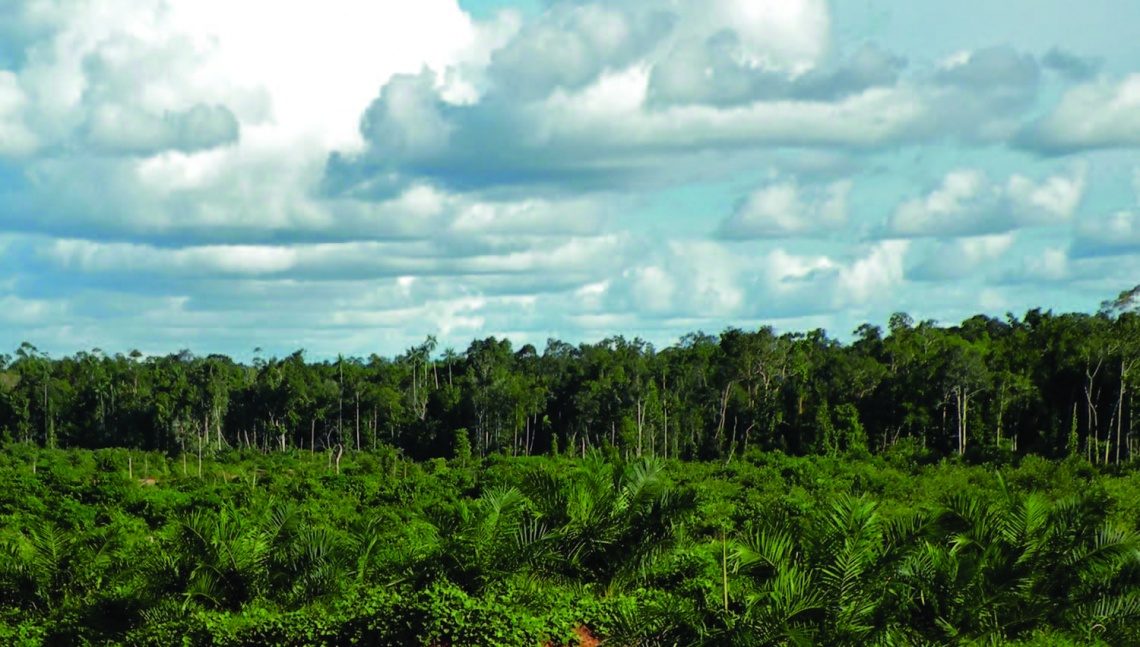If you happened to read my book review in the Spring 2015 edition of the Green Living Journal, I cited the research from Michael Moore on Salt Sugar Fat. In the review I covered these three unhealthy ingredients that are added to almost all processed foods. However, one other unhealthy ingredient was left out of the review, and the book – palm oils.
Based on reports from the USDA, imports of palm oils reached 2.7 billion pounds in 2012. For comparison, 380 million pounds is the amount of oil estimated to have been spilled by the BP Deepwater Horizon disaster. As you can see, we have a lot of palm oil in our food supply. Often palm oils are listed as vegetable oils, or other names, so you can’t always tell palm from the other oils.
‘So what”?, you might ask. Why should I care about palm oils? Palm oil plantations are mostly planted from lands previously occupied by rainforests or tropical peat bogs in Indonesia and Malaysia, as well as in Africa and Latin America. Based on a report from the Union of Concerned Scientists in 2013, “oil palm plantations worldwide take up 40.6 million acres (16.4 million hectares)—a total area greater than the U.S. state of Georgia” (Food & Agriculture Organization 2013).
Tropical forests store large amounts of carbon—both in primary (old-growth) forests and secondary (disturbed and regenerating) forests. When these forests are cleared to make way for oil palm plantations, a large amount of carbon is released into the atmosphere as carbon dioxide (CO2), the leading cause of global warming. Tropical deforestation accounts for about 10 percent of total global warming emissions (UCS 2013).
Carbon release is particularly severe where deforestation occurs on peat soils, which release enormous amounts of CO2 when  cleared and drained. Other consequences include numerous critical wildlife species are put at risk with loss of habitat. Laborers who work the crops are notoriously low paid, toil long hours, and have few benefits.
cleared and drained. Other consequences include numerous critical wildlife species are put at risk with loss of habitat. Laborers who work the crops are notoriously low paid, toil long hours, and have few benefits.
If you read labels, you may see a claim of ”‘made from sustainable palm oil” in the nutrition panel. The palm industry formed the Roundtable on Sustainable Palm Oil (RSPO) in 2004 to help the palm industry address the negative consequences of the palm farming practices. By their own admission, the RSPO has fallen short in providing effective guidance to producers on more sustainable growing practices.
With all the environmental consequences, what are the nutritional benefits of palm oils? According to the USDA, “A few plant oils, including coconut oil, palm oil, and palm kernel oil, are high in saturated fats. Most of the oils that are high in saturated fats and/or trans fats have less monounsaturated or polyunsaturated fats. Saturated fats and trans fats tend to raise “bad” (LDL) cholesterol levels in the blood”. Some nutritional benefits are claimed by the American Palm Oil Council – such as “palm oil is easily digested, absorbed and utilized in normal metabolic processes, free of cholesterol and trans fatty acids, rich in carotenoids, contain vitamin E antioxidants and provides linoleic acids”. Great if you really need these nutrients from palm oils and not from other foods.
The palm industry also claims that palm oils are less expensive to produce than other comparable oils, but they exclude the costs of deforestation and climate change from their calculations. This makes the price of palm oils artificially low and puts price pressure on other oils, which are produced with less environmental damage. The low price encourages prepared food producers to include palm oils (and their fatty, addictive qualities) into more foods. And so the cycle continues.
I suggest the concerned reader investigate further the palm oil benefits and consequences. Personally, our family reads the ingredients lists and looks for environmentally-friendly ingredients!
Ken Condliff was the founder and self proclaimed CNO (Chief Nutty Officer) of Nut-tritious Foods located in Vancouver, WA
For more info: http://www.nut-tritiousfoods.com
Top Photo by Agus Andrianto for Center for International Forestry Research.






